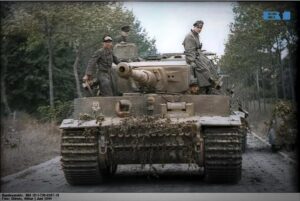Introduction
The Battle of Villers-Bocage, fought in June 1944, was a key engagement during the Normandy campaign of World War II. This battle highlighted the formidable power of the German Tiger I heavy tank, particularly under the command of tank ace Michael Wittmann. The encounter between German and British forces showcased the strategic significance of armored warfare and left a lasting impact on military history.
Background of the Battle
The Strategic Importance of Villers-Bocage
Villers-Bocage was a small yet crucial town in Normandy, controlling key routes for the Allied advance after D-Day. Its capture was essential for British forces aiming to encircle German defenders and break through their lines. Holding this position meant securing a pathway toward Caen, a major objective in the Normandy campaign.
The Deployment of British and German Forces
The British 7th Armoured Division, known as the “Desert Rats,” spearheaded the advance into Villers-Bocage. Their forces included Cromwell and Sherman Firefly tanks, supported by infantry and reconnaissance units. Meanwhile, the German 101st SS Heavy Panzer Battalion, equipped with Tiger I tanks, was stationed nearby, ready to counter any Allied movements.

The Role of the Tiger I Tank
The Design and Firepower of the Tiger I
The Tiger I tank was one of the most powerful armored vehicles of World War II. Armed with an 88mm KwK 36 gun, it could destroy enemy tanks from long distances with remarkable accuracy. Its thick armor made it nearly impervious to many Allied anti-tank weapons, making it a formidable opponent on the battlefield.
Michael Wittmann and His Legendary Ambush
German tank commander Michael Wittmann, a highly skilled and decorated soldier, played a decisive role in the battle. On June 13, 1944, Wittmann led his Tiger I in a surprise assault against the British column. Within a short span, he single-handedly destroyed multiple tanks, half-tracks, and trucks, causing heavy losses and disrupting the British advance.
The Battle Unfolds
The British Advance and Initial Success
At dawn, British forces moved into Villers-Bocage, initially encountering little resistance. They secured key positions and expected minimal opposition from German forces. However, their advance lacked proper reconnaissance, leaving them vulnerable to an ambush.
Wittmann’s Attack and Devastating Impact
Seizing the opportunity, Wittmann launched a daring assault. His Tiger I tank advanced swiftly, firing with deadly precision. In less than 15 minutes, he destroyed over a dozen British vehicles, including tanks and transport units. The ambush threw the British forces into disarray, forcing them to retreat.
Aftermath and Consequences
British Response and Counterattacks
Following the devastating ambush, the British attempted to regroup and launch counterattacks. Despite their efforts, they struggled to regain control of Villers-Bocage. The superiority of the Tiger I in direct combat proved overwhelming, leading to further losses on the Allied side.
The Legacy of the Battle
The Battle of Villers-Bocage became one of the most famous armored engagements of World War II. It demonstrated the importance of strategic planning, reconnaissance, and tank superiority. The legend of Michael Wittmann grew, solidifying his reputation as one of the most effective tank commanders in history. However, his success was short-lived, as he was later killed in battle in August 1944.
Conclusion
The Battle of Villers-Bocage serves as a testament to the power of armored warfare and the critical role of tanks in World War II. The German Tiger I tank, with its unmatched firepower and armor, played a decisive role in shaping the outcome of the engagement. While the battle ultimately delayed the British advance, it also highlighted the resilience and adaptability of Allied forces, who would go on to achieve victory in Normandy. This historic clash remains a key study in military strategy and the evolution of tank warfare.
